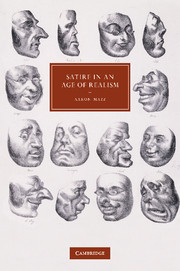Book contents
- Frontmatter
- Contents
- Preface
- Acknowledgments
- 1 Augustan satire and Victorian realism
- 2 Terminal satire and Jude the Obscure
- 3 George Gissing's ambivalent realism
- 4 The English critics and the Norwegian satirist
- 5 Truth and caricature in The Secret Agent
- Epilogue
- Notes
- Bibliography
- Index
- CAMBRIDGE STUDIES IN NINETEENTH-CENTURY LITERATURE AND CULTURE
3 - George Gissing's ambivalent realism
Published online by Cambridge University Press: 04 April 2011
- Frontmatter
- Contents
- Preface
- Acknowledgments
- 1 Augustan satire and Victorian realism
- 2 Terminal satire and Jude the Obscure
- 3 George Gissing's ambivalent realism
- 4 The English critics and the Norwegian satirist
- 5 Truth and caricature in The Secret Agent
- Epilogue
- Notes
- Bibliography
- Index
- CAMBRIDGE STUDIES IN NINETEENTH-CENTURY LITERATURE AND CULTURE
Summary
THE PLACE OF REALISM IN FICTION
There are too many writers in George Gissing's New Grub Street: too many reviewers and aspiring novelists, too many critics and petty journalists, too many scribblers trying to eke out £50 a year from their unwanted prose. Nearly all exist on the margins of the London literary scene; only a very few manage to break through to success. Focal among the novelists is Edwin Reardon, the once somewhat successful but now blocked and deteriorating writer, who in the course of New Grub Street manages the notable feat of succumbing to twin states of degradation: aesthetic (he consents under duress to writing trash) and material (he surrenders to poverty and eventually dies in abjection). Foremost among the legion of essayists and occasional writers is the atrocious Jasper Milvain. Milvain is Reardon's opposite and complement: he is savvy, he is unscrupulous, and he is successful. He sees the London literary scene with total clarity, and he adapts dexterously to its warping demands. In the end he even marries the late Reardon's beautiful wife.
It is easy to remember New Grub Street as a novel oscillating between these two figures – the wretched loser and the cunning victor. Indeed, together, Reardon and Milvain could be said to embody two sides of Gissing himself: on the one hand, the writer he knew himself to be, the psychological novelist with exacting standards (but who really wants to be a classicist living in Greece); on the other, the figure he understood he needed in some way or another to become, the crafty player who knows what it takes to survive.
- Type
- Chapter
- Information
- Satire in an Age of Realism , pp. 70 - 104Publisher: Cambridge University PressPrint publication year: 2010



